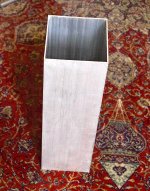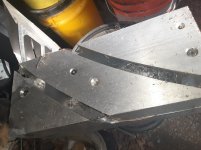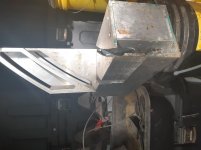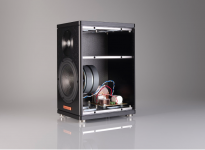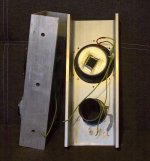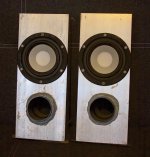What do you guys think of aluminium as a cabinet material? Interested in all kinds of views and actual experiences.
Here's an example of a cabinet that could be used for a bookshelf 2-way. It's 150mm square OD, 142mm ID, 505mm high. Volume 10.2 litres. Walls are 4mm. It resonates to F above middle C, 350hz as it is.
The walls could be damped internally, and an outer layer could be added very easily on the sides, e.g. plywood or MDF or whatever.
A top and bottom would have to be added, so I'm also interested in how that would be attached. We're talking metalwork here so solutions may vary from wood - more bolts. The speaker units would be bolted on for example. I'd expect the top and bottom to be removable.
The treble unit could be either in the cabinet or above and set back to align with the mid bass.
Views?
Here's an example of a cabinet that could be used for a bookshelf 2-way. It's 150mm square OD, 142mm ID, 505mm high. Volume 10.2 litres. Walls are 4mm. It resonates to F above middle C, 350hz as it is.
The walls could be damped internally, and an outer layer could be added very easily on the sides, e.g. plywood or MDF or whatever.
A top and bottom would have to be added, so I'm also interested in how that would be attached. We're talking metalwork here so solutions may vary from wood - more bolts. The speaker units would be bolted on for example. I'd expect the top and bottom to be removable.
The treble unit could be either in the cabinet or above and set back to align with the mid bass.
Views?
Attachments
What do you guys think of aluminium as a cabinet material?
Some of the best sounding speakers today are made out of aluminium panels, so it must be great for cabinets.
As for your proposed project i would expect too numerous issues to overcome to be worth it. Where is the attraction? Looks? Ease of using something ready made that is almost a box?
Aluminum could probably work, it is somewhat inert compared to most other metals. But it would probably have to be braced and dampened.
I wouldn't use anything on the outside, that would just take away what's cool with it.
If you want to use metal on the inside you could look at how some do in car audio, pretty common there to weld up a steel frame that they cover with MDF.
I wouldn't use anything on the outside, that would just take away what's cool with it.
If you want to use metal on the inside you could look at how some do in car audio, pretty common there to weld up a steel frame that they cover with MDF.
Aluminum could probably work, it is somewhat inert compared to most other metals. But it would probably have to be braced and dampened. I wouldn't use anything on the outside, that would just take away what's cool with it.
Yes, aluminium is cool. But the walls need damping. I was thinking of damping the 2 sides with nice looking hardwood or Baltic Birch, presumably with a rubber-ish layer of something in between.
I want to keep this as a 2 way with a simple crossover and a high quality mid bass driver with a smooth rolloff. A SB Satori MW16P would just about squeeze in or a Scanspeak Revelator 15 or whatever 5" or 6" unit.
You could get a skilled welder to add internal corner tabs to which you could screw a top and bottom piece. To conceal the screws you can make the top cover screws internal. There are crimp-able threaded fasteners available that you could add for driver mounting, else screw or tap directly into the 4mm wall. As in earlier post, the car audio industry uses suitable damping materials. The type that comes to mind immediately is the bituminous one with aluminium foil on one side.
Bang and Olufsen made speakers from alloy extrusions I believe they riveted tabs ( steel angle ) to the inside to screw parts to. The used the extrusion horizontally, with the drivers mounted on plastic end pieces. You could do something similar, cutting the square section into cubes and stacking them on top of one another. Other manufacturers have used two diecast halves bolted together. I would recommend you just stick some blutac on the tube to see what difference it can make to the resonance.
Bang and Olufsen made speakers from alloy extrusions I believe they riveted tabs ( steel angle ) to the inside to screw parts to. The used the extrusion horizontally, with the drivers mounted on plastic end pieces. You could do something similar, cutting the square section into cubes and stacking them on top of one another. Other manufacturers have used two diecast halves bolted together. I would recommend you just stick some blutac on the tube to see what difference it can make to the resonance.
Good ideas - I already thought about the horizontal idea. I should try that before cutting a round hole in the cabinet. It wouldn't work as a bookshelf speaker against a wall but it would work fine in free space. One simple way to secure top and bottom (or front and back if horizontal) would be 4 x threaded rods, one in each corner. I don't know if these would resonate. They would be screwed up tight at least.
Yes, aluminium is cool. But the walls need damping. I was thinking of damping the 2 sides with nice looking hardwood or Baltic Birch, presumably with a rubber-ish layer of something in between.
I want to keep this as a 2 way with a simple crossover and a high quality mid bass driver with a smooth rolloff. A SB Satori MW16P would just about squeeze in or a Scanspeak Revelator 15 or whatever 5" or 6" unit.
Yes covering some sides with wood could do the trick. Use something like Sikaflex to glue it up, it will add some dampning as well.
What do you guys think of aluminium as a cabinet material? Interested in all kinds of views and actual experiences.
Here's an example of a cabinet that could be used for a bookshelf 2-way. It's 150mm square OD, 142mm ID, 505mm high. Volume 10.2 litres. Walls are 4mm. It resonates to F above middle C, 350hz as it is.
The walls could be damped internally, and an outer layer could be added very easily on the sides, e.g. plywood or MDF or whatever.
A top and bottom would have to be added, so I'm also interested in how that would be attached. We're talking metalwork here so solutions may vary from wood - more bolts. The speaker units would be bolted on for example. I'd expect the top and bottom to be removable.
The treble unit could be either in the cabinet or above and set back to align with the mid bass.
Views?
Something more practical to build and acoustically superior would be more like this:
Jim Rogers JR149 (Vintage) | Hi-Fi News
Something more practical to build and acoustically superior would be more like this:
Jim Rogers JR149 (Vintage) | Hi-Fi News
Very useful reminder - I used to have a pair. I didn't keep them long but it's a good idea. Cylindrical aluminium with cutout for front baffle. Top and bottom joined with a single rod. Thanks for that.
That looks like 1/8" wall on the square tube in the photo. Just food for thought; I milled some of that stuff with 1/4" sidewall and the resonance was so loud that I had to use double hearing protection to even be in the building during the cutting operation. Eventually I had to install internal bracing just to cut the stuff and I eventually scrapped the project.
You can see how bad the chatter was even after three massive blocks were fastened internally to stiffen it up.
You can see how bad the chatter was even after three massive blocks were fastened internally to stiffen it up.
Attachments
Aluminium is stiff but not damped enough for internal loss. Plus the metal surface are good sound reflexion and transmiter due to vibration.
I beleive Magico did the trick with angled panel to break the resonances and to avoid flat panels to act as a big planar surface transmitter ! I'm not sure any complex shape inside the cabinet aka bracings would change things
I'd think it twice before to make aluminium cabinet or at least very narrow ones ! Lead at the opposite has an ideal dampening factor not only due to its weight but its plasticy, of course not practicable but in case of layered sandwich between two ply layers, polymers, etc.
I beleive Magico did the trick with angled panel to break the resonances and to avoid flat panels to act as a big planar surface transmitter ! I'm not sure any complex shape inside the cabinet aka bracings would change things
I'd think it twice before to make aluminium cabinet or at least very narrow ones ! Lead at the opposite has an ideal dampening factor not only due to its weight but its plasticy, of course not practicable but in case of layered sandwich between two ply layers, polymers, etc.
Last edited:
Right. I've studied the Magico A1 construction very thoroughly and can add some details about the Al cab. They used 3/8" plates for the sides, front and back. The top and bottom are much beefier approx. 1" thick plates (this is how they conceal any fasteners, very clever). Finally there is an additional internal baffle between the drivers.
This is a very economical construction and much easier to deal with than tubing. When dealing in aluminum, 3/8" is probably the minimum thickness you would want to work with. 1/2 or 3/4 would be a lot better. Also, flat Al plate is much more economical, so you can get 1/2", or whatever, plate off ebay and bolt it together, minus the fastener concealment trickery of the Magicos.
Edit: If thicker material creates tooling problems you could use whatever thickness your tools will handle and make a honeycomb laminate, again using 1/2" thick nomex or Al honeycomb core (just like the Magico Q).
This is a very economical construction and much easier to deal with than tubing. When dealing in aluminum, 3/8" is probably the minimum thickness you would want to work with. 1/2 or 3/4 would be a lot better. Also, flat Al plate is much more economical, so you can get 1/2", or whatever, plate off ebay and bolt it together, minus the fastener concealment trickery of the Magicos.
Edit: If thicker material creates tooling problems you could use whatever thickness your tools will handle and make a honeycomb laminate, again using 1/2" thick nomex or Al honeycomb core (just like the Magico Q).
Attachments
Last edited:
I machine stuff that is VERY prone to chatter, adding a blob of blutac ( and ear defenders - I value my hearing! ) makes a world of difference. If I were to machine square alloy extrusion, I'd be tempted to wedge some wood inside.That looks like 1/8" wall on the square tube in the photo. Just food for thought; I milled some of that stuff with 1/4" sidewall and the resonance was so loud that I had to use double hearing protection to even be in the building during the cutting operation. Eventually I had to install internal bracing just to cut the stuff and I eventually scrapped the project.
You can see how bad the chatter was even after three massive blocks were fastened internally to stiffen it up.
Right. I've studied the Magico A1 construction very thoroughly and can add some details about the Al cab. They used 3/8" plates for the sides, front and back. The top and bottom are much beefier approx. 1" thick plates (this is how they conceal any fasteners, very clever). Finally there is an additional internal baffle between the drivers. This is a very economical construction and much easier to deal with than tubing. When dealing in aluminum, 3/8" is probably the minimum thickness you would want to work with. 1/2 or 3/4 would be a lot better. Also, flat Al plate is much more economical, so you can get 1/2", or whatever, plate off ebay and bolt it together, minus the fastener concealment trickery of the Magicos. If thicker material creates tooling problems you could use whatever thickness your tools will handle and make a honeycomb laminate, again using 1/2" thick nomex or Al honeycomb core (just like the Magico Q).
This is a real step forward. I have another 2 pieces of aluminium I can make into cabinets. These are fronts only, but thicker. Front is 8mm, sides are 10mm. I was wondering about making the back and sides from wood, but I could use aluminium. I have some braces that would work well to screw it together. Width is 155mm, height 380mm.
Attachments
- Home
- Loudspeakers
- Multi-Way
- Aluminium speaker cabinets
